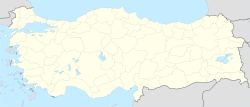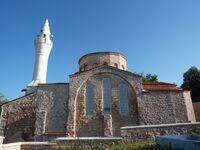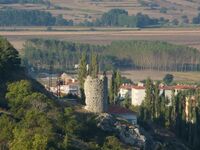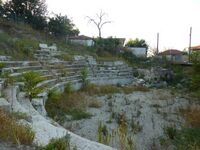ڤيزه
Vize | |
|---|---|
District | |
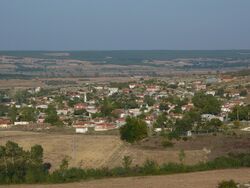 | |
| الإحداثيات: 41°34′25″N 27°45′55″E / 41.57361°N 27.76528°E | |
| Country | |
| Region | Marmara |
| Province | محافظة قرقلر إلي |
| District | 1922 |
| Municipality | 1923 |
| الحكومة | |
| • Governor | Savaş Ünlü |
| • Mayor | Sedat Balkı (MHP) |
| المساحة | |
| • District | 1٬090٫63 كم² (421٫09 ميل²) |
| المنسوب | 168 m (551 ft) |
| التعداد (2012)[2] | |
| • Urban | 12٬543 |
| • District | 28٬228 |
| • كثافة District | 26/km2 (67/sq mi) |
| منطقة التوقيت | UTC+2 (EET) |
| • الصيف (التوقيت الصيفي) | UTC+3 (EEST) |
| Postal code | 39400, 39410, 39460, 39480 |
| مفتاح الهاتف | 0 288 |
| Licence plate | 39 |
| الموقع الإلكتروني | www |
Vize (باليونانية: Βιζύη, بالبلغارية: Виза) is a town and district of محافظة قرقلر إلي in the Marmara region of Turkey. District's governor is Savaş Ünlü, and the mayor is Sedat Balkı (MHP). In 2010 the population of the town was 12,196 and the district 29,153. The town's distance to the province center is 56 km (35 mi). Vize is situated on the state road Invalid type: D, which runs from Istanbul to Edirne through Kırklareli.[3]
التاريخ
Vize, under the ancient name Bizya or Bizye (باليونانية قديمة: Βιζύη) served as capital for the ancient Thracian tribe of the Asti, and was mentioned by several ancient authors.[4][5] The acropolis section up on the hill above the town has some ancient buildings and a perfectly preserved Byzantine Church of Haghia Sophia from probably the 5th or 6th century AD.[6] Also, on the slope of the acropolis was recently found the remains of its ancient theater. Vize with its beautiful setting on the hilltop is in a commanding position over the surrounding area. Across the plain from the town are many burial mounds built for the rulers of Thracian Kingdom. There are some more churches and monasteries, mainly from the Byzantine era, in the neighborhood of Vize. The town also has some Ottoman structures, in addition to an ancient synagogue.
According to the Ottoman population statistics of 1914, the kaza of Vize had a total population of 14.109, consisting of 10.020 Muslims and 4.089 Greeks.[7]
From inscriptions it seems that during the late 1st century BCE Bizye was under local rule of the Sapians rather than under direct Roman control.[8]
The martyrs Memnon and Severos were killed in Bizye as part of the Diocletianic Persecution beginning in 303.[8] In 353 CE, the exiled Eustathius of Antioch chose to settle in Bizye, where he later died.[8] The city is documented as the seat of an archbishop, as a suffragan of Heraclea, as early as the 5th century.[8]
Beginning in the 6th century, water was piped from Bizye to Constantinople, and some of the pipes are still visible.[8] In 773 or 774, the emperor Constantine V had a bridge built here.[8]
Bizye is described as a city (polis) in the province of Europe in the Synecdemus of Hierocles, as well as later in the De Thematibus of Constantine Porphyrogenitus.[8]
The city appears to be identical with the "Uzusa" (باليونانية: Οὔζουσα) mentioned in the council in Trullo in 692, which was signed by one Geōrgios elachistos episkopos Uzusēs tēs Thrakōn chōras.[8] Since there is no signature for a representative of Bizye in the document, it is assumed that they are the same place.[8]
Proto-Bulgarian inscriptions indicate that Khan Krum captured and probably destroyed Bizye.[8] During the 9th and 10th centuries the city served as the head of a tourmarches.[8] In the aftermath of Thomas the Slav's rebellion in 823, his stepson Anastasios attempted to take refuge in Bizye but was handed over by the city's residents to the emperor.[8] The folk saint Maria Nea lived in Bizye after her marriage in 896 to Nikephoros, who was tourmarches here.[8] After her death in 903, she was venerated as a saint, and her cult became very popular in Bizye and the surrounding regions.[8]
The Bulgarian emperor Simeon I captured Bizye in c. 925 after a five-year-long siege; the city's walls were destroyed, and most of its population fled to nearby Medea.[8] Whether Bizye was later targeted during Peter I's campaign in eastern Thrace in 927 is uncertain.[8]
In the 12th century, the Arab geographer al-Idrisi described Bizye as a large and well-fortified city in a fertile valley, with thriving commerce and industry.[8] When Cuman invaders came and looted eastern Thrace in 1199, a Byzantine army was dispatched from Bizye to repel them.[8] They were at first successful, but their initial victory was squandered because the Byzantine troops got greedy.[8]
After the sack of Constantinople in April 1204, Bizye became part of the new Latin Empire as per the Partitio Imperii Romaniae.[8] The city did not submit to the Latins at first, and it wasn't until March 1205 that it was brought to heel, along with the similarly rebellious cities of Arcadiopolis and Tzurulon.[8] Just one month later, though, the Latin army was defeated by a combined force of Bulgars and Cumans led by Tsar Kaloyan, who then launched a series of invasions throughout eastern Thrace.[8] Bizye was one of the few cities in the region that remained unaffected by the incursions.[8] Toward the end of 1205, the nobleman Anseau de Cayeux was sent to garrison the city along with 120 knights.[8] Later in June 1206, the emperor Henry of Flanders set up camp at Bizye, which was honored as "mult ere bone et forz".[8]
Sometime after 1225, an Epirote force under Theodore Komnenos Doukas advanced on Bizye, but they were unable to take possession of the city.[8] In 1237, the Cumans again invaded Thrace; many of Bizye's residents were captured and sold as slaves.[8] In August 1246, the Latin emperor Baldwin II negotiated a deal with the Order of Saint James which would have ceded Bizye and Medea to the order along with possessions in Constantinople, but the treaty was ultimately never put into effect.[8] In 1147, Bizye (along with Tzurulon, Medea, and Derkos) came under control of John III Doukas Vatatzes, who had allied with the Bulgarians.[8]
Either at the end of 1255 or the beginning of 1256, the emperor Theodore II Laskaris defeated a combined Bulgarian and Cuman force somewhere between Bizye and Bulgarophygon.[8] He then concluded a peace treaty that fixed a new border in the upper Maritsa valley.[8]
From 1286 to 1355, Bizye was the center of one of three known military districts called megala allagia (the other two are Thessaloniki and Serres.[8] This district covered the entire area stretching roughly from Mesembria in the north to Arcadiopolis in the west and the suburbs of Constantinople in the east.[8]
At the end of the 13th century or beginning of the 14th, a prostitute from Constantinople named Anna Kremaste died in Bizye.[8] In 1304, a large Byzantine army was assembled at Bizye, commanded by emperor Michael IX and Michael Doukas Glabas Tarchaneiotes in an attempt to stop a Bulgarian incursion under Theodore Sviatoslav.[8] The Byzantines had already been defeated at Skaphidas and then at Bizye they were defeated again.[8]
In 1307, over the protests of the megas tzausios Humbertopoulos, the local population attempted to fight a Catalan force with Turkish auxiliaries under the command of Ferran Ximenes de Arenos.[8] They were defeated, and the Catalans looted the city.[8] The city was again looted in 1313, this time by a Turkish force led by one named Ḫalil; the Turks were later defeated in battle at Xerogypsos.[8]
In the winter of 1322, Syrgiannes Palaiologos captured Bizye along with Raidestos and Sergentzion, but almost immediately lost the city to the forces of Andronikos III Palaiologos.[8] Andronikos himself stayed in Bizye for several days during the summer of 1324 due to an illness.[8] That September, Bizye's annual donation to the Patriarchate of Constantinople was set at 100 hyperpera.[8] Andronikos returned to Bizye with an army in 1328, in anticipation of an attack by his former ally Michael Shishman that never came.[8] In the summer of 1332, the theologian Matthaios of Ephesos stopped in Bizye en route to Brysis, where he had been appointed to office; he only stayed briefly, but he wrote that there were numerous holy wells or hagiasmata in the area, which were consecrated to the Blessed Mother.[8] The area around Bizye was described as unsafe due to the presence of robbers at that time.[8]
In 1344, Bizye was captured by John VI Kantakouzenos, and he installed his general Manuel Komnenos Raul Asen as governor of the city.[8] A few years later, in the late 1340s, a force of 1,200 Turkish horsemen penetrated Byzantine territory as far as Bizye.[8] After Matthew Kantakouzenos was forced to abdicate the imperial throne, Bizye remained under his effective control, and he stayed here several times in 1356.[8]
As part of a synodal act in August 1355, which ratified an alliance between the emperor John V Palaiologos and Ivan Alexander of Bulgaria, the metropolitanate of Bizye was given the archdiocese of Derkos as an epidosis for a short time of about two years.[8] A similar thing happened with the diocese of Stauropolis in July 1361.[8]
The inhabitants of Bizye were possibly resettled in 1357 or 58, perhaps because of Turkish brigands taking advantage of the fact that the city's garrison had been depleted by the fighting between John V Palaiologos and Matthew Kantakouzenos.[8]
In the autumn of 1358, Manuel Asanes, Matthew's uncle-turned-enemy, asked John V to make him governor of Bizye.[8]
In 1368, Bizye came under the control of the Gazi Turks along with other areas in the southern Istranca mountains.[8] The metropolitan of Bizye was reassigned to Mesembria and Anchialos to compensate for the loss of Bizye.[8] Bizye was again conquered by the Turks in 1403 and then probably reconquered by the Byzantines under Manuel II Palaiologos in 1410.[8] Bizye came under Turkish control for the final time at the beginning of 1453, possibly by the troops of Karaca Paşa.[8]
The Turkish traveler Evliya Çelebi visited Vize in 1661, during his sixth trip.[8] He described it as the seat of a sanjak-bey, inhabited by a mixture of Turks, Bulgarians, and Greeks, and famous for its leeks.[8]
معالم
Little Hagia Sophia Church (Gazi Suleiman Pasha Mosque) (تركية: Küçük Ayasofya Kilisesi (Gazi Süleyman Paşa Camii)) is a former Byzantine era Orthodox church built during Emperor Justinian I (reigned 527-565) times, which was converted later in the Ottoman era into a mosque. Designed in an Orthodox Basilica plan, the church was constructed upon the foundations of the Temple of Apollo with masonry stone and brick. The cruciform shaped church consists of a nave with two rows of columns with three columns each, two aisles and an apse at one end. Its original wooden roof was replaced in the 12th and 13th centuries by a high dome. The building is vaulted around the dome, a different style that is normally not seen in Byzantian architecture.[9]
Vize Fortress (تركية: Vize Kalesi) is a fortification constructed in the Ancient Roman era. It is situated at the northwest of the town. It is believed that the fortress was built originally in 72-76 B.C., and was revived during the Justinian I times. It is constructed of clear cut stones and rubble masonry upon foundations with stone blocks of 50 cm × 80 cm (20 in × 31 in) and 100 cm × 150 cm (39 in × 59 in). The bluish color of the stones at the northern wall indicates that this section was rebuilt in the Late Byzantine era during the Palaeologian dynasty. The fortress consists of two nested walls. The western and southern city walls are intact. An inscription in Greek alphabet letters carved on stone, which was found at the fortress, says "Here were watchtowers built under the administration of Firmus, the son of Aulus Pores, along with Aulus Kenthes, the son of Rytes the son of Kenthes, and Rabdus, the son of Hyakinthus." It is exhibited at Kırklareli Museum.[10]
Amphitheatre (تركية: Antik tiyatro) is an open-air theatre built in the 2nd century during the Late Roman era, the only known one in Thrace. It was discovered in 1998 during archaeological excavations carried out for Çömlektepe tumulus. Parts of the Roman theatre, which still exist, are the cavea (spectators' seats) with aisles between the seats, the scaenae (stage) and orchestra. Reliefs from the scaenae frons, the background of the stage, are exhibited in the Kırklareli Museum.[11]
معرض صور
المراجع
- ^ "Area of regions (including lakes), km²". Regional Statistics Database. Turkish Statistical Institute. 2002. Retrieved 2013-03-05.
- ^ "Population of province/district centers and towns/villages by districts - 2012". Address Based Population Registration System (ABPRS) Database. Turkish Statistical Institute. Retrieved 2013-02-27.
- ^ "Vize Belediyesi" (in التركية). Yerel Net. Retrieved 2011-12-17.
- ^ قالب:Cite Pliny
- ^ قالب:Cite Stephanus
- ^ Byzantine Church - Ottoman Mosque - Endangered Architectural Monument: An Architectural and Archaeological Survey of the Hagia Sophia at Vize
- ^ Kemal Karpat (1985), Ottoman Population, 1830-1914, Demographic and Social Characteristics, The University of Wisconsin Press, p. 170-171
- ^ أ ب ت ث ج ح خ د ذ ر ز س ش ص ض ط ظ ع غ ف ق ك ل م ن هـ و ي أأ أب أت أث أج أح أخ أد أذ أر أز أس أش أص أض أط أظ أع أغ أف أق أك أل أم أن أهـ أو أي بأ بب Külzer, Andreas; Koder, Johannes (2008). Tabula Imperii Byzantini Bd. 12. Ostthrakien (Eurōpē). Wien: Börsedruck Ges.m.b.H. ISBN 978-3-7001-3945-4. Retrieved 13 November 2021.
- ^ "Küçük Ayasofya Kilisesi (Süleyman Paşa Camii)" (in التركية). vize.com. 2006-04-05. Retrieved 2011-12-18.
- ^ "Vize Kalesi" (in التركية). vize.com. 2006-04-05. Retrieved 2011-12-18.
- ^ "Antik Tiyatro (Odeon)" (in التركية). vize.com. 2006-04-05. Retrieved 2011-12-18.
وصلات خارجية
- Pages using gadget WikiMiniAtlas
- CS1 التركية-language sources (tr)
- Articles with hatnote templates targeting a nonexistent page
- Short description is different from Wikidata
- Coordinates on Wikidata
- Articles containing Greek-language text
- Articles containing بلغارية-language text
- Jct template errors
- Articles containing Ancient Greek (to 1453)-language text
- Pages using Lang-xx templates
- Official website different in Wikidata and Wikipedia
- مقاطعات محافظة Kırklareli
- أماكن مأهولة في الامبراطورية البيزنطية
- Tourist attractions in Kırklareli Province
- بلدات ومدن رومانية في تركيا
- أماكن مأهولة في محافظة قرقلر إلي
- Districts of Kırklareli Province
- بلدات تركيا
- Cittaslow
